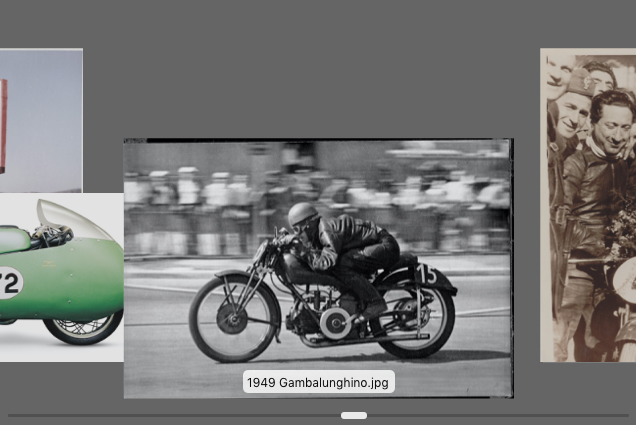To understand MotoCorsa, you need to get to know Arun Sharma – although he no longer works there, everyone agrees that he’s the guy who created the dealership’s unique culture and retail brand.
Motorcycles aren’t exactly the Sharma family business; Arun’s mom & dad, and his sister, are all college professors. He was an English major who left Wisconsin on a long and winding motorcycle journey – that ended with a Life-flight to a hospital in Mesa, Arizona. He took that as a sign Arizona was not for him. A friend suggested Portand.
After working a few low-level retail jobs, Arun settled into an art shop where he worked as a framer. “I ended up in sales, and in the late ’90s I started an online business called TheArtBroker.com,” he told me. “It was great. I was living the life of Reilly in a cool apartment in downtown Portland but I worked by myself. I decided that I needed another job around other people.”
While Arun was sitting around in his underwear, selling art online, Ducati came back to Portland. A successful regional auto dealer group, Ron Tonkin Dealerships, started selling Ducs out of an existing Ferrari dealership. When Arun heard that Tonkin was about to move the Ducati franchise to a stand-alone store near Nike’s headquarters in the suburb of Beaverton, he applied for a part-time sales job.
“Of course the GM’s first question was, ‘Had I ever worked in a bike shop?’” Arun recalled. “When I said no, his second question was, ‘Then how are you going to sell Ducatis?’ I told him that I sold fine art and rode a Ducati, and that I’d figure it out.”
The new shop was staffed like a car dealership. “The sales manager was a guy from a big multi-line store. He would just stand there with his hands on his hips while I talked to a customer. He’d take me aside and ask, ‘Are they buying?’” Arun recalled. “I’d say, No, they’re just looking, and he’d say, ‘Don’t waste your time talking to them, go find someone who’s buying a bike today.’”
Sharma sometimes ran out of the shop, to catch customers as they left so he could apologize for the shitty customer experience they’d just had. When that got old, he decided to quit, but he wanted to hand his resignation to the owner, Brad Tonkin. When Tonkin asked why Arun was leaving, he spoke from the heart.
“When you sell a brand like Ducati, you’re a steward of that brand,” Arun told him. “It’s not a widget; it’s almost a member of the family.”
You can guess where this story’s going: Tonkin offered to let Arun run the shop. In case you think it was all sunshine and lollipops from then on, however, you should know that Sharma summarily fired almost the entire staff. (Only the shop’s best tech was spared, because he had a great attitude and also, I suspect, because Arun realized he had to keep the service department ticking over.)
He re-staffed the shop in his own image, hiring a bunch of young guys (and gals) who all loved bikes. They may not have had much experience, but Arun told them, “All the times you’ve said, ‘Wouldn’t it be cool if?..’ Well, now we can do those things.”
“I really wanted to curate a community,” Arun told me. “It wasn’t, ‘What are you going to buy today?’ I just wanted to make you feel comfortable and welcome. It was like ‘Cheers’ for motorcycles – a place where everyone knew your name.
In the mid-2000s, Sharma went back to his boss, Brad Tonkin, and convinced him that MotoCorsa had outgrown its suburban location. Arun was sure that it would do better in an urban setting, and found the dealership’s current location – a 10,000 square-foot industrial building close to downtown Portland, in an area that was either hip or gritty depending on your point of view.
He hired Skylab Design, a highfalutin’ architecture firm that had never designed a motorcycle dealership; the company specialized in things like fancy boutique hotels. He told his architect that he wanted a retail setting that showcased motorcycles as if they were works of art.
“I was hyper-involved, and I drove my staff crazy because I micro-managed them,” Sharma admitted. “People say I’m hard to work for. I’m an asshole, I have high standards; I wouldn’t want to work for me. But I had a very particular vision and to deliver it, I had to start with people who got it.”
When I asked what ‘getting it’ meant, Arun answered from a customer’s perspective. “The short answer is, you walk into the shop and you meet someone, or more than one person, and when you walk out you’ve made new friends.”
He continued, “Beyond that, the world’s a big and daunting place. So if you’re going to do something, it’s really nice to have someone who makes you think, ‘That’s my guy!’ – someone who is going to do what’s best for you, not what’s best for him.”
“Over the years, I got in regular fights with my sales staff, because they would want to sell someone the wrong bike. I wouldn’t sell a new rider a bike that was way out of their league. My salesmen would say, ‘They’re just going to go and buy one somewhere else.’ Well, too bad; I can only control what I can control.”
So ‘getting it’, in Arun’s vision, is the oldest trick in marketing. ‘It’ is making customers believe that you are their friend. And the way you do that is, you actually become their friend. Remember that hands-on-hips sales manager who asked whether the customer was going to buy today? Arun was happy to chat about motorbikes with customers who came in every few weeks for years – years! – before purchasing.
That’s a radical difference from most motorcycle dealerships, which operate on the principle that in every transaction there’s a winner and a loser; the Sales Manager’s job is run up the score on that loser customer
For years, motorcycle dealers have been fighting for a bigger slice of a shrinking pie, and the double-your-profit, control-the-sale mindset has resulted in most dealerships providing customer experiences that alienate all but the most determined buyers.
So far, I’ve been describing MotoCorsa’s growth in the early 2000s, when the whole motorcycle industry was booming. That all changed at the beginning of the 2008 model year, when U.S. motorcycle sales dropped by half.
“One thing I’ve always believed is that motorcycles are your escape from the real world,” Arun told me. “People buy motorcycles to meditate, to turn off, to light up from the inside. To get away from the bullshit. In 2008, when the crash happened I said, ‘Here’s what we’re going to do: Everyone’s going through shit, so when they walk through our doors, we’re going to make them forget all about it. Never mention money or the economy; we’re only going to talk about motorcycles and fun.’ In June of 2008 we sold 61 motorcycles and broke a record for Ducati North America.
Jason Wilson is MotoCorsa’s sales manager. He’s been with the shop for nine years, over which time he’s seen the rise of online comparison shopping.
“Nowadays, I definitely see customers fewer times before they purchase,” he told me, “because they’ve done so much research online.” Customers who comparison shop online can trigger a race to the bottom among retailers, but MotoCorsa’s mitigated that trend by maintaining a large fleet of bikes with a liberal demo-ride policy – after all you can’t take a test ride online. Even more important, they’ve created a sense of community.
“It’s no accident,” Wilson told me, “that we have a disco ball in the showroom. We throw parties and they’re not necessarily even motorcycle focused. They’re just for fun – these are our friends; we’ve made friends by selling them bikes, but that’s not the only thing they do. Obviously we have the conventional sales – Black Friday or whatever – but at the end of the day it’s those extra touch points that make the difference, and most dealers just don’t do those things.”
When it come to bricks-and-mortar retail, the Internet taketh away, but it giveth, too. MotoCorsa’s been a savvy – often disarmingly offbeat – user of social media
A few years ago, Ducati released a typically sexist set of ‘wallpapers’, of scantily clad women draped over an 1199 Panigale. MotoCorsa responded with a calendar of its own male staffers. I’d describe them as cross-dressers but some were hardly dressed at all.


































